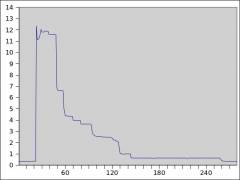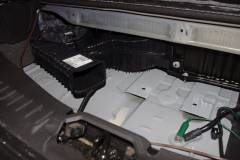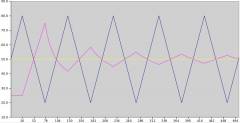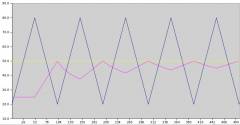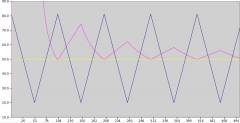-
Posts
1,234 -
Joined
-
Last visited
-
Days Won
185
Content Type
Profiles
Forums
Gallery
Everything posted by SnowStorm
-
Here is a plot of 12V battery current just from opening the driver's door and closing it again. (Interior lights were set to stay OFF.) I ordered an inexpensive multimeter with 0.00 millivolt resolution and an optically isolated RS232 output for data logging. As you can see, plenty of points along the way that, if things stopped shutting off, battery would get drained quite handily. BTW, just inserting the key (not turning at all!) will cause the current to go to 5 amps for about 10 seconds. Removing the key causes about 3 amps. Nothing happens on the dash. After 30 minutes or so, current drops to essentially zero (0.00 mv reading on my meter). X Axis = DC Amps - Y Axis = Samples (almost 2 per second)
-

C Max 12V Bat Amps Open Close Door (interior lights OFF)
SnowStorm posted a gallery image in Member Albums
From the album: SS
Current drawn from 12V battery when door is opened - then closed. (Interior lights were set to stay off.) Millivolt drop across ground cable used to calculate current. -
Well folks, its a "feature" - and I didn't even know The Enterprise had an ambient light sensor. With all your comments in mind I grabbed a bright LED flashlight and headed out to experiment. Sure enough, there is the sensor in the middle of the dash. I jump in, switch on the lights (park or headlamps - doesn't matter), shine flashlight on sensor, dash lights get brighter, take flashlight away, lights go dim again. But then, what's this? I notice that the left edge of the Old Dominion inspection sticker is almost directly over the sensor! So, I can imagine driving along with sun on the sensor, turn a few degrees, no sun on sensor! I guess all the rest was just coincidence. Now, inspection is about due so I'll have them put sticker a bit further to the right. So don't blame Ford - blame the gov'nor!
-
Has anyone seen the instrument lights get brighter and dimmer as you drive - all on their own? Or am I just ignorant about something? We've been riding for several hours (SE model), parking lights on, instrument lights fully dimmed (usual position) and I decide to switch the left screen to Fuel History. Fine. After several minutes I look down and see the car switch to EV and the instrument lights suddenly get brighter! A few minutes later they go dim again. This happened several times. I checked the dimmer setting and it was always at minimum. I hadn't been on this screen for ages and had never seen this happen before - on other screens. Was this some programmers "easter egg" to highlight going into EV? Only on this screen? But no, at other times EV came on with no change in dimming. I tried other screens and came back to Fuel History. It happened again. I never saw it happen on another screen (coincidence?). The change looked the same as when you turn the car lights on and off (which I wasn't doing). "Trivia post of the day" perhaps, but can anyone explain this behavior? (My wife saw it too, so I'm not calling the eye doctor!)
-
Looking mighty sharp! Now spring will come? We had a bit of snow this morning. Maybe if all of us give our cars a "spring cleaning" it will shame winter away!
-

Tesla Allowed to sell cars in Ohio
SnowStorm replied to JohnnOhio's topic in Articles, News & Reviews
O Model X, Model X! wherefore art thou Model X? Deny thy dealer and refuse the shame; Or, if thou wilt not, be but sworn my ride, And I'll no longer buy a Car direct. -
Hadn't heard about the ground connection problem. Just checked mine and got 0.55 millivolt drop with 3.12 millivolts across the ground cable. Looks fine to me. Paul, Just now my battery read 12.00 to 12.08 at front with all lights out. Car had been out in 31F weather for several hours so battery is colder than usual (may affect voltage). Opening rear hatch to turn all the little lights on gave 11.71 in front and 11.74 in rear at battery. After closing hatch, voltage at front went to 11.97. At other times I had read about 12.4 to 12.6 with lights out. ..."I don't like the look of it"....
-
Plus 3: Hadn't really planned on logging but thought about it - the data would be quite interesting. Main plan was just to be able to walk by the car, say an hour after parking, and see that no current is being drawn. Paul: That seems odd for sure. There might be some shutdown sequence that leaves something on. daveyork suggests turning everything off before switching off the key and I think that is a good precaution. But the fan coming on like that makes no sense.
-
The 12V battery problem hasn't gone away so I want to monitor actual current into/out of the battery. Measuring voltage, although helpful, has problems. It can be OK one evening and dead the next morning if there is too much current flowing all night. Here's what I've done so far. Removed the big plastic cover/tray that goes across the back. There are 3 screws along the front edge and one 10mm(?) nut in a deep pocket near where the ground cable bolts to the frame. The two outside rear corners are held in place with spring clips - you pull the whole thing straight up once the screws and nut are removed. Connected a two conductor wire to each end of the big ground cable that runs from the negative post to the car's frame. The ground cable now acts as a current "shunt" producing a very small voltage that is proportional to current per good ol' ohms law. Ran the wire under the rear compartment "flooring" into the rear seat area where it could be connected to a digital multimeter set for DC volts. You need one that can indicate down to 0.1 millivolts. DO NOT CONNECT ANY WIRES TO THE POSITIVE TERMINAL! Calculated the resistance of the ground cable by measuring the current through a light bulb connected across the battery and the voltage drop across the "shunt". Two different bulbs gave the same value of 0.54 milliohms (0.00054 ohms). Now you have the value so "don't try this at home"! Current can now be calculated as: 12V Battery Current (amps) = Voltage Reading (millivolts) / 0.54 Or in "round numbers", just take the DC millivolts and multiply by 2 to get amps. If the car's frame is positive (relative to negative post), the battery is discharging. If the battery post is positive (relative to car's frame), the battery is being charged. With car OFF, opening/shutting the door sends the current to about 8 amps. After a minute or so it steps its way down to about 0.4 amps. Then after maybe 30 minutes or more it finally drops to under 0.01 amps. (Used a very high resolution meter here as you are down in the microvolts.) The rear cargo lights appear to draw a bit over 1 amp. They eventually turn off if hatch is left open (at least it happened once while testing). Next step should be to build a little micro-power monitor I can run from the accessory jack that can stay in the car all the time. Just look through the window and see how it is doing. But we shouldn't have to do any of this!!!Here are the monitor connections. For the curious, here is the sticker on my new battery. The bar code number you can't read is 31508 53155. Note the 100 month warranty (36 months free)! Since it doesn't start the ICE it should almost last forever. Quite a pity we're having ANY dead battery problems. The left side of the battery compartment looks like this with the HV battery fan (Made In USA!). It should point straight out the back for a bit of jet assist! :lol:
-
From the album: SS
-
From the album: SS
-
From the album: SS
-
IMHO you could double the size of the battery and still have trouble if the cause is a large current draw that doesn't turn off. My recent incident (here) happened literally overnight and left the battery at 3.44 volts. Let the car sit a few days and any battery will be dead if the current is high enough.
-
Sounds like a good idea to me. Will start doing it. We had our SE for 8 months, 20,000+ miles with NO battery problems. Had the battery FSA done 2-1/2 months ago (including a new battery) and have had two dead batteries since then (more details here) - although we "thought" we left ignition ON the first time. Help! Looks like I'm forced to build a battery monitor.
-

Shouldn't FE go up faster than it goes down.
SnowStorm replied to John Sparks's topic in Fuel Mileage
It could be just an issue of initial conditions. Look at the following graphs where we start with different initial conditions for SOC and whether ICE is ON or OFF. The modeling assumes a long term average of 50 MPG and the ICE running 50% of the time (1 mile per cycle). Here we start with a "full" battery and the ICE OFF. Indicated MPG will be "infinite" (999.9 if it shows at all) until ICE turns ON and MPG drops like a rock to 50 MPG. Then it goes to 74 and back down to 50. Each cycle drops more than it goes up because the long term average must settle "down" to 50 MPG. Dark blue is SOC and Magenta is MPG. Now we start with an "empty" battery and the ICE ON. Indicated MPG is steady at 25 until ICE turns OFF and MPG rises to 50 MPG. Then it drops to 37 and goes back up to 50. Each cycle rises more than it drops because the long term average must settle "up" to 50 MPG. In this case you could say "FE goes up faster than it goes down". It all depends on the initial conditions. Not surprisingly, if you start with SOC at 50% (ICE On in this case), the graph centers around the long term average. All of which goes to show why its best to start (and if possible end) all comparisons with SOC at 50%. Things work out a little nicer. But if you're trying for the 600 mile/tank club, start with a full battery (jus' don't tell Jus! :secret: )! -
From the album: SS
MPG over time starting from reset with 50% SOC and ICE On. Assumes 50% ICE and 50 MPG long term average with SOC varying between 20 and 80%. -
From the album: SS
MPG over time starting from reset with 20% SOC and ICE On. Assumes 50% ICE and 50 MPG long term average with SOC varying between 20 and 80%. -
From the album: SS
MPG over time starting from reset with 80% SOC and ICE Off. Assumes 50% ICE and 50 MPG long term average with SOC varying between 20 and 80%. -
The Enterprise (SE) has had no 12V battery problems for 8 months - then we have the battery "fix" done and now it goes dead! :gaah: The history: Car is at dealer the end of last December for body work and the 12V battery service action is called for (forget the number) so they check, replace 12V battery and do the reprogramming. Service tech said something about how we were in danger of finding the car dead. Within a week we leave the ignition on and the car is dead - battery at 2.5 volts! :rant2: Why isn't it smart enough to turn itself off? Start charging with my Schumacker model SSC-1500A charger which pulses on and off with car lights blinking (eek!) for several hours. I called the dealer and the service tech thought it would eventually charge up but could take a while. He was right. It took many hours - it finally started charging smoothly and after many hours went to 100%. Life was good for 10 weeks. Then, literally overnight, the car is stone dead with 3.44 volts at the under-hood charge connections. We jump in the 15 year old and go our way. (Now I'm wondering if we really left the ignition on the 1st time!) Come home and connect charger again. Pulses a long time as before but without any lights flashing on/off. Again it takes like 12 hours to get it charged. It has now sat for a day (while it snowed outside ) at 13.1+ volts, opened the door (12.4 volts), closed door (12.6 volts), now back to 13.1; point being, there must not be any significant parasitic drain right now as the "surface charge" must still be there. (Garage is about 55-60 F.Will call the dealer and see what's up. SnowStorm sure has a lot more empathy for those of you who have had battery problems! :sad: Still crazy about the car but dead batteries start stinking real fast! Can anyone summarize all the battery related service actions?
-

Ford dropping Microsoft Auto in favor of QNX
SnowStorm replied to valkraider's topic in Audio, MyFord, Navigation & SYNC
The car world is about to change - phones in cars, as (mis)used today, will be as old-school as points and condensers - no longer needed. Have a look: http://www.youtube.com/watch?feature=player_embedded&v=wY9AzUfSdKU Ford's switch to QNX is goooood news. Its not just about eliminating annoyances and "aliens"! Future automotive communications, infotainment and driver assistance technology needs the best in performance, reliability and security. Have a look at what this OS runs now: http://www.qnx.org.uk/company/30ways/ -

Ford dropping Microsoft Auto in favor of QNX
SnowStorm replied to valkraider's topic in Audio, MyFord, Navigation & SYNC
Hurray! I was rather horrified when I first heard that Ford was going to put MS Windows in cars. QNX has been around a long time and is a true "real-time" operating system. This change is a real step forward IMHO. Sure hope present systems can be upgraded. -
Yes! Love the wagon - would be a great hybrid or Energi. So would the B-Max!
-
Hmmm... so Paul moves from Atlanta area to SoCal (or any of us from similar area) to get better mileage: Average sales price in Forsyth, Fulton, Dekalb, Fayette counties GA = $106.50 / Sq-ft Average sales price in Ventura, LA, Orange and San Diego counties = $282.50 / Sq-ft Sale of old 2000 Sq-ft home in Atlanta = $200,220 (after paying realtor) Cost of new 2000 Sq-ft home in SoCal = $565,000 Moving expenses = $10,000 Total cost = $374,780 Now assume yearly MPG average goes from 40 to 50 with 25,000 miles / year: Yearly cost in GA = 25,000 / 40 * $3.21/gal = $2006 Yearly cost in CA = 25,000 / 50 * $3.69/gal = $1845 Fuel savings per year = $161 Payback = $374780 / $161 = 2324 years!!! P.S. We gotta do something to keep our brains from freezing (about 0oF here yesterday)!
-
No kidding. The Enterprise took a hit end of last month. :sad: Both my dealer and an independent shop estimated between $1400 and $1500 but the insurance only said about 60% of that. Sounds like a bit more "adjusting" to be done. :spend: Its going to the dealer after Thanksgiving. A new fender is only $134. If you blend paint into the door, the HYBRID emblem on the door must come off and can't be re-used. A new one is $50. But it would make a nice magnet for the fridge. Then I'd have a hybrid fridge! 47 calories per kilowatt! :lol:
-
Several more suggestions: Set MyView screen to show the Climate/Accessories graph. Now you can monitor A/C power on the climate graph. I don't think the fan matters much - its the A/C compressor that can burn the kilowatts. Avoid recirculation setting in wet conditions so moisture doesn't build up inside the car. When using the normal defroster hit the A/C OFF button and allow just some heat to clear the glass. If you want some heat anyway, it doesn't make sense to run the A/C too. Warm air will often clear the glass just fine. It always worked in the "old days"! Try setting the vents the way you want for comfort and then using the Max Defrost button in short bursts as needed. I have found it very effective if you can stand turning it on and off occasionally. It may use A/C but it turns the heat and fan way up and gets the job done quickly. Let it clear the glass, maybe run a few seconds more, then turn it back off - things go back to normal. I think it is one of the best climate features on the car.So, monitor the climate graph as you experiment and remember that fogged glass results from a combination of (1) moisture in the car and (2) glass that is too cold. Defrost with A/C running can become a vicious circle - glass fogs because it is too cold - defrost (with A/C) clears it but makes it even colder - glass now fogs all the quicker :twister: while your mileage goes to pot. :spend:



